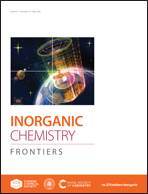NH3 plasma-etching-derived porous N-doped carbon nanotubes with FeP nanoparticles and intrinsic carbon defects for boosting oxygen reduction in rechargeable Zn–air batteries†
Abstract
Modulating intrinsic activity and coupling with transition metal phosphides are encouraging strategies to enhance the electrochemical performance of carbon-based materials. In this study, N-doped carbon nanotubes were derived from polyaniline nanotubes by the guided growth of the soft template micelles comprising Fe3+ ions and methyl orange. Phytic acid was employed to detain Fe3+ ions from washing away so as to form iron phosphide (FeP and Fe2P) nanoparticles. NH3 plasma etching was further exerted for concurrent phase engineering of iron phosphide nanoparticles by transforming Fe2P to FeP, creating intrinsic carbon defects, as well as regulating the specific surface area and pore structure of the N-doped carbon nanotubes. It demonstrated that the phase transformation from Fe2P to FeP with higher crystallinity, together with the generated intrinsic carbon defects, played significant roles in promoting the oxygen reduction reaction (ORR) performance of the porous N-doped carbon nanotubes. As expected, the optimized composite (denoted as CV-FeP/NPCNT-30) revealed brilliant electrocatalytic ORR performance in 0.1 mol L−1 KOH aqueous solution, holding a more positive half-wave potential of 920 mV (vs. Reversible Hydrogen Electrode), a high diffusion limiting current density of 5.89 mA cm−2, delightful stability and methanol tolerance. Consequently, the liquid Zn–air battery (ZAB) established with CV-FeP/NPCNT-30 as the electrocatalyst in air-cathode manifested an outstanding power density (221 mW cm−2) and specific capacity (851.5 mA h g−1Zn), outperforming the liquid ZABs based on the commercial Pt/C and some relevant electrocatalysts recently reported.



 Please wait while we load your content...
Please wait while we load your content...